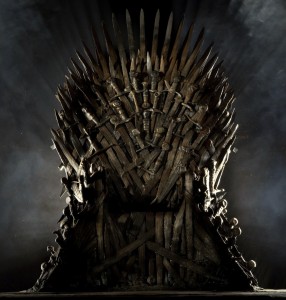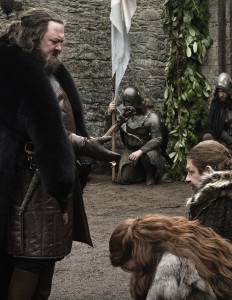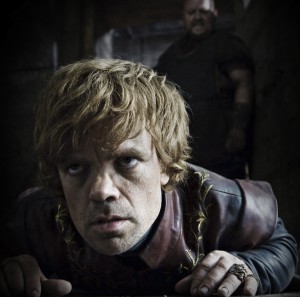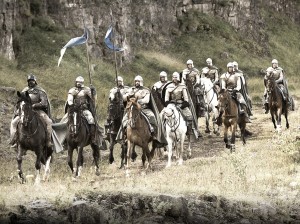A story about a boy who hated stories ("Game of Thrones" mid-season analysis)
Adapting a beloved work of literature for the screen can be a dicey prospect in the best of times. When you’re dealing with a television adaptation of a book written in part as a deliberate revolt against the constraints of television dramas, the pitfalls are quite evident. And that’s the precise challenge that HBO gave itself when it decided to turn George R.R. Martin’s fantasy series “A Song of Ice and Fire” into an epic miniseries.
 Some of my friends, fans of Martin’s books, have found it difficult to accept the production, for not living up to their vision of the books. To them I say, you are entitled to your opinion, but you are nuts.
Some of my friends, fans of Martin’s books, have found it difficult to accept the production, for not living up to their vision of the books. To them I say, you are entitled to your opinion, but you are nuts.
Others (even professional critics for august newspapers) have dismissed “Game of Thrones” based largely on an antipathy for the fantasy genre that Martin’s books and HBO’s adaptation loosely inhabit. Nothing can please everyone, but hopefully most people are capable of recognizing exceptional works regardless of genre classification. I’ve got minimal desire to read romance novels, but having read it I appreciate that “Pride and Prejudice” is an enjoyable masterwork. Maybe “A Song of Ice and Fire” isn’t on the level of Austen, or the doyen of fantasy literature, Tolkien (though some have argued it is) but the critical consensus seems that Martin’s intricate plotting and complex characterization far outclasses many of the mass-market series filling the fantasy and science fiction sections of libraries and bookstores.
I’ve only seen just over half the 10-episode first season of “Game of Thrones,” but as events pick up steam towards the twist-laden climax, I can confidently give the program two thumbs up. It’s gotten all the big things right — the plot preserves Martin’s schemes and twists, the acting is solid across the board, the production design is thorough enough to allow anyone but a skeptical medieval historian to suspend disbelief. The result is a TV series that’s not only enjoyable entertainment but also one with something to say.
For a series where so much of the action is kicked off by events in the past, there’s one notable element missing from “Game of Thrones”: flashbacks.
There are dozens of scenes in HBO’s adaptation of George R.R. Martin’s fantasy series where characters simply sit around and talk about events in the past. HBO tries to spice these scenes up, frequently by making the character have sex as he (and it’s always been a he) declaims. But not once does HBO ever show viewers Jaime Lannister stabbing the Mad King, or young Robert Baratheon smashing skulls, or the infant Viserys and Daenerys being spirited away from Dragonstone ahead of Stannis Baratheon’s fleet.
In doing so, HBO is closely following Martin’s prose, which is set resolutely in the present tense. But it was by no means a foregone conclusion that a television adaptation wouldn’t use time-tested techniques of visual storytelling to cut down on some of the talkiness. (Had a Hollywood studio adapted Martin’s series, as some were reportedly interested in doing, I’m pretty confident there would have been a whole lot more showing and less telling.)
The decision to stick with the talking was in part, I’m sure, a budget-driven choice: between makeup, casting additional actors as younger versions of characters, and staging some of the more elaborate battles and set-pieces in the history of Westeros, flashbacks would have driven up the series’ already large (but not quite large enough) budget. But so constrained, producers David Benioff and D.B. Weiss made their forced choice into a deliberate artistic statement. “Game of Thrones” is a self-consciously literary television series, with words and stories an important part of the show’s plot, themes and character development.

This is shown most clearly through the character of Robert — the character most firmly stuck in the past. Robert’s youth featured martial glory and the love of his life, but his greatest triumph saw him deprived of both and forced to become a peacetime king. Ably portrayed by Mark Addy as a pitiable shell of a man, almost all of Robert’s conversations come back to the past in one way or another. One bit of his dialogue, as he tells about the first time he killed a man, captures the ethos of “Game of Thrones” towards stories more than anything:
They never tell you how they all shit themselves. They don’t put that part in the songs. (Episode 3, “Lord Snow”)
“Game of Thrones” embraces stories, even as it undermines the concept. Stories, as Robert points out, never tell the whole truth — and almost all the adults in “Game of Thrones” have things they’re not telling. Some, like Tyrion, Varys and Littlefinger, wield words like weapons, persuading or tricking others’ to do things for them. Others, like Robert, Ned and Jaime, have events in their past they’d rather other people didn’t know about —although this hope is usually for naught. Both Ned and Jaime live with their shame in full view — Ned in the form of his bastard Jon Snow, Jaime in the epithet “Kingslayer” he won for the particularly lethal bit of lèse majesté he pulled off at the end of Robert’s Rebellion. Theon Greyjoy, too, tries to fit in with his Stark hosts — only to be constantly mocked for being not a guest but a hostage, a state of affairs he can do little about.
Just about the only major character who believes in the old stories is Ned’s oldest daughter Sansa, a true romantic with a knack for crushing on entirely the wrong people. The gallant Knight of the Flowers is playing for the other team, as the saying goes, but Loras Tyrell would still be a better match than the boy Sansa ultimately sets her heart on: Prince Joffrey Baratheon. It’s Joffrey and Sansa who deliver another crucial scene, in the sixth episode, “A Golden Crown.”
Joffrey walks into Sansa’s drawing room, apologizes for his bad behavior, gives Sansa a present — a necklace, like the one his mother wears — then promises to be true and faithful to her, to love her and make her his queen. The two kiss as strings crescendo in a love theme in the background.
Take that scene out of context, and it’s a classic fairy tale romance. The prince, who’s behaved badly to the girl he loves, wins back her heart and seals his promise with a chase kiss. But watchers of the whole series know Joffrey is a spoiled monster, cruel and spiteful, who has been urged by his more cunning mother to make nice with Sansa despite despising her as a holier-than-thou rube. “Game of Thrones” plays the moment straight — from Sansa’s perspective — but it’s not spoiling anything to reveal that Sansa’s romanticism is going to be dashed sooner rather than later.

The world of “Game of Thrones” is one where happy endings don’t exist. Bad people win, good people die — and often both those things happen because of , and not despite, the high moral principles of the heroic. When the mercenary Bronn and the knight Ser Vardis Egen meet in ritual combat, Egen fights with honor and Bronn doesn’t — and it’s Bronn who walks away (and Bronn the audience cheers) while Egen, weighed down both by his chivalry and his armor, takes a more abrupt exit.
But what works on the pages of a book — where there’s little difference between reading about an event and reading someone telling about an event — doesn’t always work on the screen. To make this literary approach to Martin’s story pay off on the small screen, a TV show puts a lot of weight on the shoulders of the actors. People like Sean Bean, Mark Addy, Peter Dinklage, Lena Headey, Aidan Gillen and Emilia Clarke have to deliver monologues that are both convincing and interesting.
By and large, the “Game of Thrones” cast consistently rises to the challenge. Bean personifies “noble and stoic,” Dinklage captures not just Tyrion’s stature but his wit and debauchery, while Headey fills out a role that was largely two-dimensional in the pages of Martin’s first book. After the season’s first six episodes, all the major actors — and there’s a lot of them — have acquitted themselves ably. If some characters are annoying or unlikable, it’s the characters who were meant to be so — Sansa and Viserys, respectively. In particular, as Viserys actor Harry Lloyd (who I keep picturing in his role as the arrogant boarding school lordling Baines in the “Doctor Who” episodes “Human Nature” and “The Family of Blood”) elevates a role that could easily come off as a stock villain into a pitiable fool, whose ambitions exceed both his talent and his sanity, doomed by his own madness to meet an unfortunate end.
With few exceptions, the show’s sets and costuming are also effective. I’m not the biggest fan of the thick eyeliner Jason Momoa wears as the barbarian warlord Khal Drogo, but the “Game of Thrones” designers paid the sort of attention to detail that post-“Lord of the Rings” audiences expect from fantasy productions. Similarly the sets — filmed in Malta and Northern Ireland — are largely convincing, with miniature work combining with on-site filming to create a believable world of castles, inns, forests and steppes. Special mention goes to the more dramatic settings: the Wall, Martin’s massively high ice barrier at the northern end of the civilized lands, which comes off as properly awe-inspiring from both its base and its peak, and the Eyrie, the mountain fastness with its perilous dungeons and brutally efficient Moon Door.

If there’s any flaw to highlight in the “Game of Thrones” production, it’s scale. The culprit here is obvious: the show’s large but limited budget. While the Wall (presumably produced with a combination of miniature work and CGI) is suitably majestic, two repeated sequences come off as somewhat less so. Khal Drogo is supposed to be the warlord of an unstoppable horde of 40,000 Dothraki screamers, pseudo-Mongol horselords from the East. But while Drogo is an impressive-enough physical specimen, inattentive viewers of “Game of Thrones” might be mistaken for counting him chief of no more than 400 warriors. Even $5 million an episode isn’t enough to go truly massive (like Peter Jackson’s “Lord of the Rings” adaptation did with the similarly equestrian Rohirrim), so it’s understandable that we don’t see Drogo’s khalasar blackening the plains. But HBO doesn’t seem to even try to sell the idea of Drogo’s massive army with the usual trickery of close-ups, quick cuts and matte paintings. This is far from a fatal flaw, but I hope it’s one the producers address for the second season, which much more than Season 1 revolves around the movements and clashes of massive armies.
This same problem of scale showed itself with the Hand’s Tourney. In the books — and in the show’s dialogue — the Hand’s Tourney is an extravaganza, a spectacle the bankrupt king can’t afford but insists on anyway. Knights, men-at-arms and sellswords from all over the Seven Kingdoms travel to the capital to compete in the joust and melee, while throngs of hangers-on and spectators pack the city and turn out to watch the show. In addition to advancing several plotlines, the events of the tourney serve an important secondary purpose: by bringing the Who’s Who of Westeros all in one place, Martin gets to introduce characters who won’t make an impact until considerably later in the series, mentioned in passing as a competitor in the Tourney. It’s the last great event of Westeros at peace under Robert’s reign, the last time many warriors will meet before clashing on the battlefield, and Martin uses the sporting combat of the Tourney to set up the more brutal, less chivalrous warfare that’s about to come. Yet on screen, we not only see just two jousts (perhaps understandable, for plotting reasons), but the crowd hardly amounts to the throngs described by captain of the city watch. I’ve seen more people gathered to watch fake jousts at Medieval Times.
As with Khal Drogo’s undersized clan, the anemic crowds and competitors at the Hand’s Tourney don’t severely detract from the enjoyability of the series. But events will only get bigger as “Game of Thrones” moves into subsequent seasons, and if some of the coming battles don’t get the illusion of scale right, the series will definitely suffer.
So far it’s managed to withstand these few shortcomings to be fantastic television that I, a fan of the books, and my uninitiated friends have all been able to enjoy. In fact, my biggest complaint about the show might actually be that, at only 10 episodes in length, “Game of Thrones” is close to being done for the year. Fortunately, right around the time the season wraps, Martin will finally release the long-delayed fifth book in his series, sating my desire for his brutally realistic brand of fantasy for at least a little while longer.